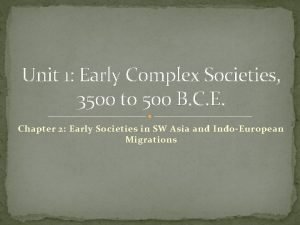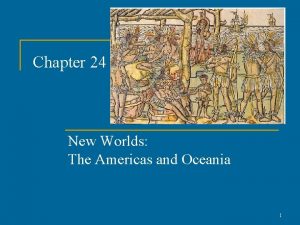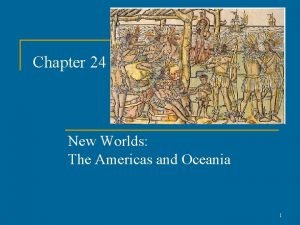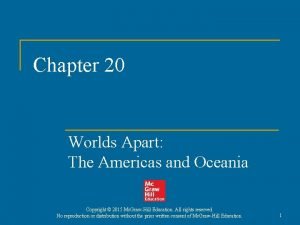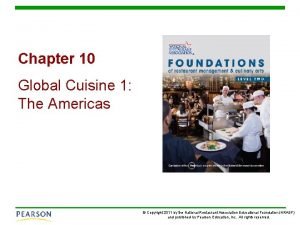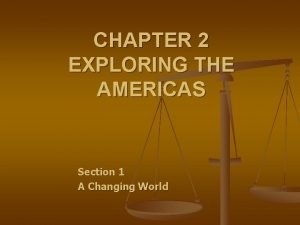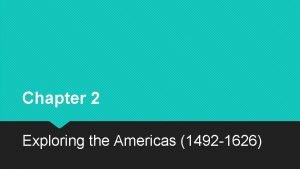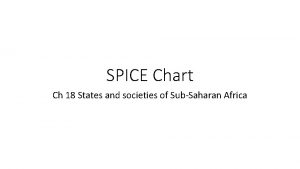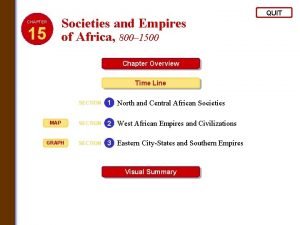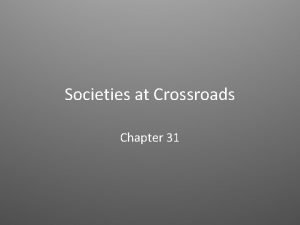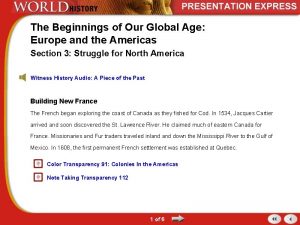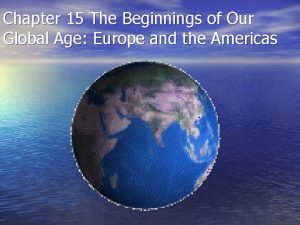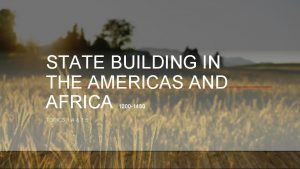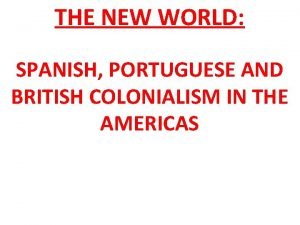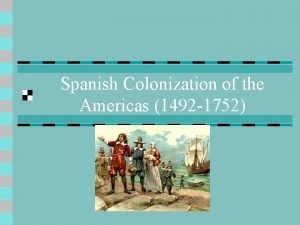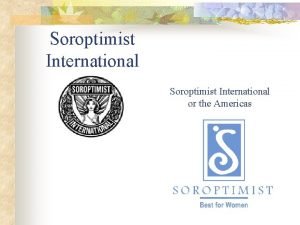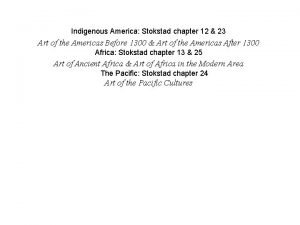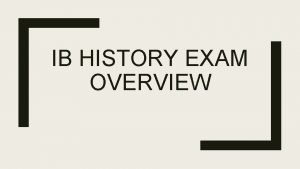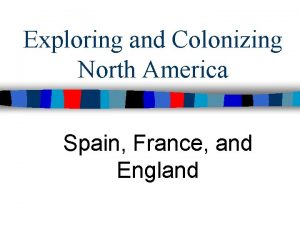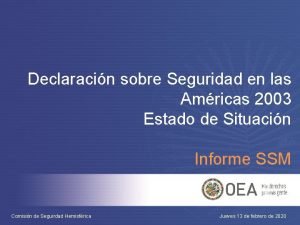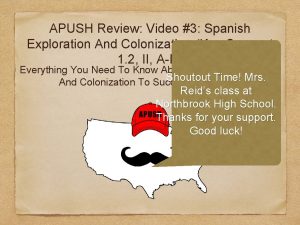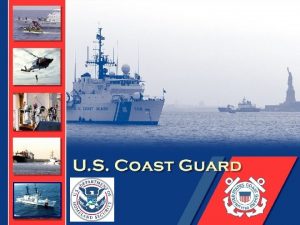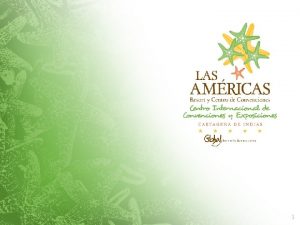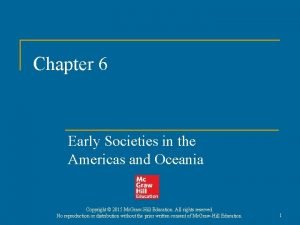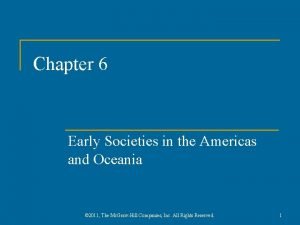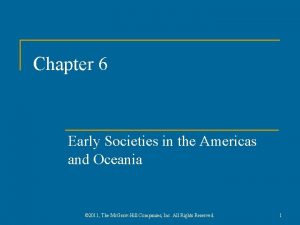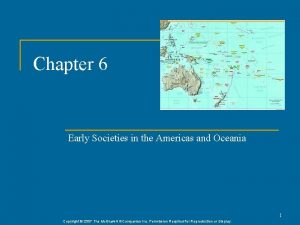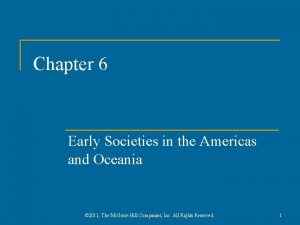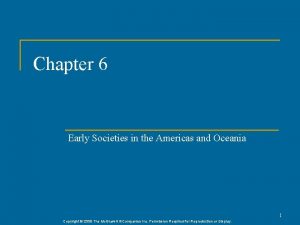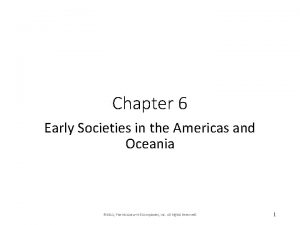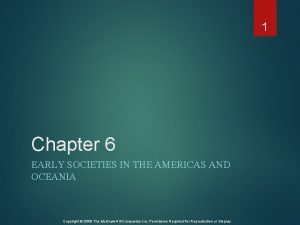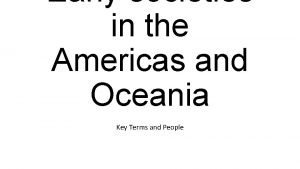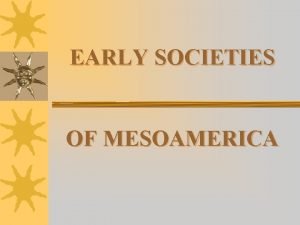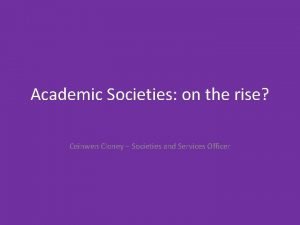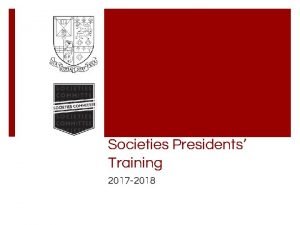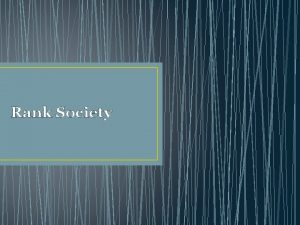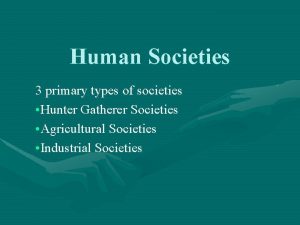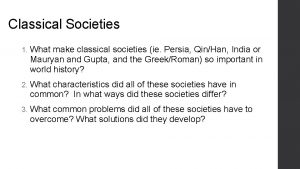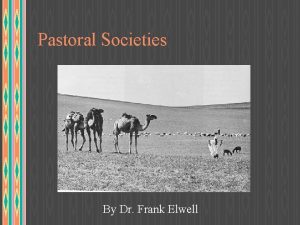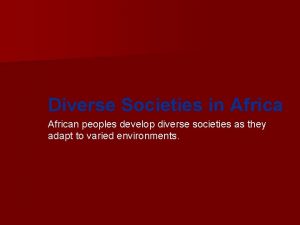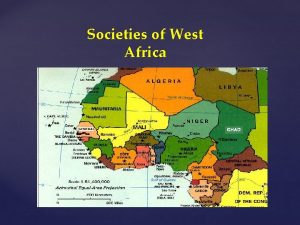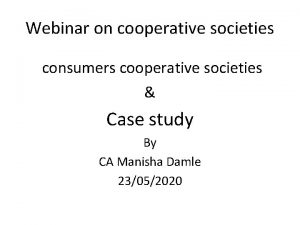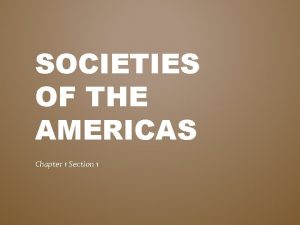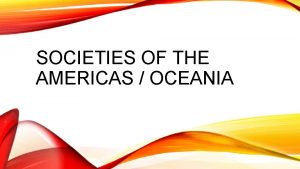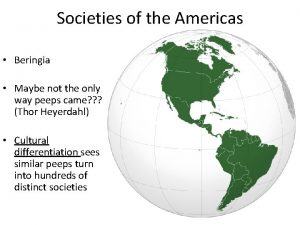Chapter 6 Early Societies in the Americas and


























- Slides: 26

Chapter 6: Early Societies in the Americas and Oceania Early Mesoamerican societies, 1200 B. C. E. -1100 C. E.

Ceremonial centers, calendar, Maize, basalt heads, ball game Olmecs 1200 -100 BCE

Olmec Jade Ear Flares Olmec Jade Mask

500 BCE – 650 CE Pyramid of the Moon

Teotihuacan Pyramid of the Sun v important ceremonial center v extensive trade network (obsidian) v begins to decline 650 CE, sacked and then abandoned v home to 200, 000 v theocracy, little evidence of military, professional merchants v evidence of ball game, adopted Olmec writing, calendar


The MAYA: El Mirador: 150 BCE-150 CE

Danta Tigre

La Danta from Nakbe

The MAYA: Nimli Punit 500 -900 CE Tikal 500 -800 CE

Tikal 500 -800 CE Palenque 500 -800 CE

Mirador: El Tigre Vs. Central Plaza, Tikal

Lintel 24 Structure 23 Yaxchilan, Chiapas, Mexico The sculpture depicts a sacred blood-letting ritual which took place on 26 October 709. King "Shield Jaguar" is shown holding a torch, while Queen "Lady Xoc" draws a barbed rope through her pierced tongue

Bonampak Mural Noblewomen Piercing tongues Sting ray spines Needles Thorns flints


At the height of Mayan civilization, body modification included a variety of alterations of the teeth.

The Mayan calendar was very advanced, and consisted of a solar year of 365 days. It was divided into 18 months of 20 days each( haab’), followed by a five-day period that was highly unlucky. There was also a 260 -day sacred year (tzolkin), divided into days named by the combination of 13 numbers and 20 names. Two calendars would repeat Every 52 years = Calendar Round. Maya Long Count developed to record time over 52 years

Dresden Codex Bonampak, Mexico

Bishop Diego de Landa: Relacion de las cosas De Yucatan 1566

According to the Popul Vuh a book compiling details of creation accounts known to the K'iche' Maya of the Colonial-era highlands, we are living in the fourth world. [8 The Popol Vuh describes the first three creations that the gods failed in making and the creation of the successful fourth world where men were placed. In the Maya Long Count, the previous creation ended at the start of a 13 th b'ak'tun. The previous creation ended on a long count of 12. 19. 17. 19, (August 11, 3114 BCE) Another 12. 19. 17. 19 will occur on December 20, 2012, followed by the start of the fourteenth b'ak'tun, 13. 0. 0, on December 21, 2012

• • Migration into South America c. 12000 BCE Climate improves c. 8000 BCE Largely independent from Mesoamerica Highly individualized due to geography Andean Societies Polynesia/ Oceania 1500 BCE – 700 CE

Chapter 6: Early Societies in the Americas and Oceania Theme 1: Interaction between humans and the environment _______________________________ • Migration • Population pressures, trade, and the need for additional resources led to the development of complex social and political forms • no metallurgy: specialized craftsmanship: jade, obsidian, textiles (cotton) • Mesoamerica: diverse geography, early settlement along coastline not river valleys, rich food supply that becomes more diverse with agriculture (maize, beans, squash, tomato, avocado) (Olmec rubber) No native draft animals: instead have to rely on human labor/ terraced fields • Andean Society: difficult geography (Andes), early settlement along rich coast, llama/alpaca, beans, peanuts, sweet potatoes, cotton, terrain makes contact between these two American regions nearly impossible (some isolated trade: maize, squash N to S: gold, silver and copper S to N) Gold, silver and copper metallurgy (Chavin de Huantar) • Oceania: Australian Aborigines (H & G), Pacific Islands more contact with SE Asia (agriculture)

Theme 2: Development and interaction of cultures _______________________________ • Mesoamerica: basalt heads (Olmec) polytheism, bloodletting, human sacrifice, astronomy and prediction, calendar (solar and ritual), Maya hieroglyphs, (record astronomical, geneological, political and social history, record keeping, poetry, and religious texts: Popol Vuh) (records on papyrus, stelae, architectural stone, tombs, murals) Maya numerical system, concept of zero, stelae and altars, ball game, enormous ceremonial complexes, murals, pyramids and temples, great plaza areas (no written records for Olmec) • Andean Society: Chavin Cult (1000 BCE: arrival of maize), Chavin Cult prompted building of Large temples, art and pottery (everyday life) , polytheistic, animal sculpture: dedicated to fertility and abundant harvests), no writing • Oceania: spread of Austronesian language, decorated pottery, outrigger canoes

Theme 3: State-building, expansion and conflict _______________________________ • Mesoamerica: Olmec : authoritarian, socially stratified, commanded large labor pool to produce basalt heads and flood control projects, managed trade systems, some evidence of military Teotihuacan: theocracy? , no evidence of military/conquest, politically stratified, authority over immense and expansive trade network (proximity to obsidian source, three legged orange pottery) Maya: political organization varies: city states to regional empires, priest/kings (jaguar…), Continually competing over resources and regions of influence, tried to symbolically align themselves with more powerful (usually religious) centers: Kaminaljuyu, Tikal, Palenque, El Mirador Chichen Itza • Andean Society: Mochica/ Chimu (Chanvin de Huantar), regional states and cities along coast, large scale irrigation projects, trade with highlands (carried out by coercion and warfare), regional states unable to consolidate into anything approaching an empire • Oceania: Australia: egalitarian, H&G, Lapita chiefdoms (around trade), hierarchical chiefdoms

Theme 4: Creation, expansion and interaction of economic systems _______________________________ • Mesoamerica: trade, craft specialization, cacao currency, trade at times dominated by influence of Teotihuacan, lowlands traded agricultural foodstuffs for highland obsidian and jade • Andean society: built irrigation systems so that the lower valleys could support agriculture, established trade and economic networks from city to highlands (integrated economic zones) • Oceania: H&G (Australia), trading and seafaring in and around New Guinea (3000 BCE), outrigger canoes, domesticated animals (chickens, pigs)

Theme 5: Development and transformation of social structures _______________________________ • Mesoamerica: ample evidence of social stratification (art, stelae, murals, architecture), elaborate social hierarchy (kings and ruling families, priests, landowning nobility, merchants, Professional architects, sculptors, specialized artisans, peasants and slaves (majority)) • Andean Societies: similar to above, merchants probably played significant role as the trade etworks became more complex and extensive • Oceania: Australian aborigines more egalitarian
 Monotheism
Monotheism Chapter 24 new worlds the americas and oceania
Chapter 24 new worlds the americas and oceania New worlds the americas and oceania
New worlds the americas and oceania Chapter 24 new worlds the americas and oceania
Chapter 24 new worlds the americas and oceania Worlds apart the americas and oceania
Worlds apart the americas and oceania Chapter 16 people and empires in the americas
Chapter 16 people and empires in the americas Early cpr and early defibrillation can: *
Early cpr and early defibrillation can: * Chapter 10 global cuisine 1 the americas
Chapter 10 global cuisine 1 the americas Chapter 2 exploring the americas study guide
Chapter 2 exploring the americas study guide What did amerigo vespucci explore
What did amerigo vespucci explore Great zimbabwe spice chart
Great zimbabwe spice chart Chapter 15 societies and empires of africa
Chapter 15 societies and empires of africa Chapter 31 societies at crossroads outline
Chapter 31 societies at crossroads outline The beginnings of our global age europe and the americas
The beginnings of our global age europe and the americas The beginnings of our global age europe and the americas
The beginnings of our global age europe and the americas State building in the americas
State building in the americas Spanish caste system in the americas
Spanish caste system in the americas Spanish colonization of the americas
Spanish colonization of the americas Soroptimist international of the americas
Soroptimist international of the americas Art of the americas before 1300
Art of the americas before 1300 Ib questions
Ib questions English territories in france
English territories in france Declaración sobre seguridad en las américas 2003
Declaración sobre seguridad en las américas 2003 Spanish caste system in the americas
Spanish caste system in the americas Americas guardians mc
Americas guardians mc Centro internacional de convenciones
Centro internacional de convenciones Transversal de las americas
Transversal de las americas
